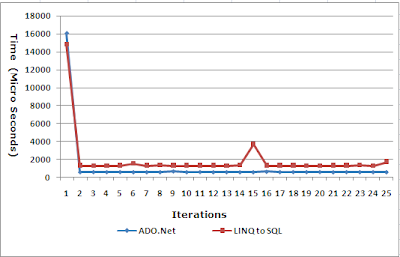In this post LINQ to SQL Vs ADO.Net
Performance Test – Calling Stored Procedures with OUT Parameter we, shall
compare the performance of LINQ to SQL and ADO.Net in executing a stored
procedure call. This stored procedure takes the Department ID (int) as the
input parameter and returns the Department Name (varchar(50)) as an OUT
parameter
Asp.Net provides a number
of Data Access Technologies, like ADO.Net, LINQ-to-SQL, Entity Framework
etc, each one of these technologies has its own advantages and disadvantages, and
while designing an application; we need to identify the appropriate data access
technology to achieve maximum efficiency.
The configuration of the system used to
perform the evaluation is as follows.
OS
|
Windows XP Professional 2002 SP3
|
Processor
|
Pentium® D 2.66 GHz
|
RAM
|
3 GB
|
The performance test was carried out for 25
iterations with both ADO.net and LINQ-to-SQL; the results of the test
are as follows.
ADO.Net Average time: 1199.16
Microseconds
LINQ-to-SQL Average time: 1962.68 Microseconds
LINQ-to-SQL Average time: 1962.68 Microseconds
The test results show that ADO.Net has performed better than LINQ to SQL, the executions time is in the ratio of 2:3 between ADO.Net and LINQ-to-SQL.
The code used to perform the test is as
follows
ADO.Net
SqlConnection objConn;
SqlCommand objCmd;
Stopwatch timer;
string strQuery = string.Empty;
timer =
new Stopwatch();
timer.Start();
string strConn = ConfigurationManager.ConnectionStrings["EmployeesConnectionString"].ToString();
objConn
= new SqlConnection(strConn);
strQuery
= "GetDepartmentName";
objCmd
= new SqlCommand(strQuery,
objConn);
objCmd.CommandType
= CommandType.StoredProcedure;
SqlParameter paramID = new
SqlParameter("DepartmentID",SqlDbType.Int);
paramID.Direction
= ParameterDirection.Input;
paramID.Value
= 1;
SqlParameter paramName = new
SqlParameter("DepartmentName",
SqlDbType.VarChar, 50);
paramName.Direction
= ParameterDirection.Output;
objCmd.Parameters.Add(paramID);
objCmd.Parameters.Add(paramName);
objConn.Open();
objCmd.ExecuteNonQuery();
objConn.Close();
timer.Stop();
lblExecutionTime.Text = "Execution
Time (Micro Seconds):" + (1e6 * timer.ElapsedTicks / (double)Stopwatch.Frequency).ToString();
LINQ to SQL
EmployeeClassesDataContext dbContext = new EmployeeClassesDataContext();
string strDepartmentName = string.Empty;
Stopwatch timer;
timer =
new Stopwatch();
timer.Start();
dbContext.GetDepartmentName(1,
ref strDepartmentName);
timer.Stop();
lblExecutionTime.Text = "Execution
Time (Micro Seconds):" + (1e6 * timer.ElapsedTicks / (double)Stopwatch.Frequency).ToString();
That’s it we have evaluated the performance
of ADO.net and LINQ-to-SQL in executing a stored Procedure with an OUT
Parameter.
RELATED POST




No comments:
Post a Comment